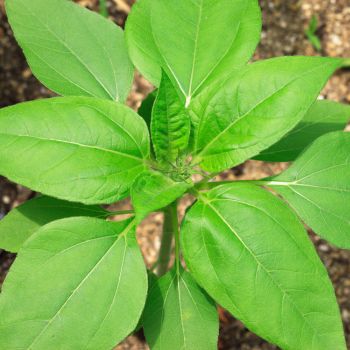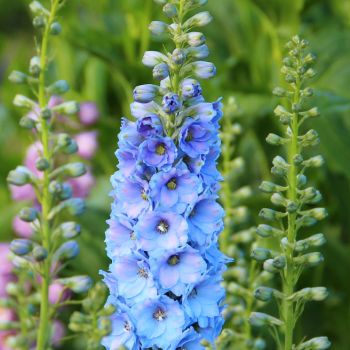The divide between a formal flower garden and a sprawling veggie patch might seem a hard one to bridge, but most gardeners know the advantages of growing some flowers to add beauty to the garden and attract beneficial insects and pollinators. Growing edible flowers not only brings these benefits to your garden, but also adds novelty and variety to your plate.
There's a wide range of flowers that can be used in the kitchen, adding colourful and flavourful garnishes to main meals, taking a starring role in impressive summer salads, and even adding a surprise touch of colour and flavour to drinks. And perhaps most importantly, growing and using edible flowers is just plain fun.
Important Safety Note
Before you start feasting on flowers there are three important safety points to bear in mind. First, only consider eating flowers from your own garden rather than harvesting them from parks, nature strips or other people’s gardens. Both wild and cultivated blooms could be contaminated with chemicals or animal waste that you don't want to ingest.
Second, only eat a flower when you're sure it's safe. Some common flowers, notably digitalis (foxglove) but also plenty of others, can be toxic or even lethal. And third, when trying a new flower, always eat it in moderation in case you have an unexpected allergic reaction.
The Best Edible Flowers to Grow
With that safety message out of the way, which common flowers make the best eating? There are many species to choose from. Some flowers probably won't raise an eyebrow thanks to their herb heritage, such as chives, anise hyssop, chamomile, lavender and sage. Others, such as pea and zucchini, are the flowers of common vegetables. Some more unusual options such as daylily and rose might be a little more surprising.
Here are five of our favourites which combine beauty in the garden with flavour on the plate.
1. Nasturtium
Nasturtiums are very versatile as all parts of the plant are edible. The leaves make a great salad leaf when young, with a peppery taste similar to rocket or cress, while older leaves can be treated like a spicier version of spinach.
The flowers add a sweet contrast to the leaves’ pepperiness, and are a great way to liven up salads as well as providing a colourful edible garnish. Kids (and adults) can pick the flowers straight from the garden and suck out the sweet nectar. And to top it off, the seed pods can be pickled at the end of the season for a homemade alternative to capers.
Best of all, nasturtiums are easy and quick to grow, with both bush and trailing varieties supplying masses of flowers in a variety of vibrant colours.
2. Calendula
The bright yellow, orange or red petals of the calendula flower combine a sweetish honey flavour with a deep colour to add a new dimension to many dishes. Scatter the petals over salads, or use them as a saffron alternative in all kinds of rice dishes. Or for hearty winter use, dry the petals and use later in the year to brighten up soups and stews.
To use calendula, cut off the whole flower head, pull out the petals by hand, and discard the rest. Frequent picking will encourage more flowers, so don't hold back.
3. Marigold
Marigold is related to calendula and offers a similarly vibrant range of yellow and orange colours. However, the flavour has citrus notes alongside a slightly sweet edge. Use smaller whole flowers as a garnish, or separate the petals from larger or double blooms and sprinkle over dishes to give an aromatic brightness that's especially good with seafood and rich, creamy sauces.
4. Carnation
Carnations are favourites for cutting thanks to their delicate beauty and vivid shades of pink, red, white and purple. But they also make a wonderful edible flower with sweet petals containing a hint of clove-like spice. The petals look great when used as garnishes on cakes and other desserts.
However, it's important to only use the petals. While the central parts and base of the flower aren't harmful, as some sources suggest, they do have a bitter taste and should be avoided.
One popular and worthwhile use of carnations is to steep the petals in sugar syrup to make a flavouring for drinks, which is delicious added to white wine for an extra edge of summer interest.
5. Viola and Pansy
Lastly, violas and pansies offer a splash of vivid colour in the garden in the cooler months, and can do exactly the same to cakes, desserts and other dishes where the delicately sweet and aromatic flavour will fit. Beyond their flavour, the great advantage of violas is the wide range of colours they come in, spanning the spectrum from white through yellow and orange to blue and purple.
Smaller flowers can be used whole, while individual petals from larger flowers are good for scattering. One impressive way to use viola petals is to paint them with a strong mix of sugar and water and leave them to dry. This not only helps to preserve them, but the candy-like results are excellent for topping the icing on a cup cake.
The idea of using flowers in a meal can seem strange or even a little pretentious to some. But the extra flavour and colour they bring can add a new dimension to your most familiar dishes, and when these examples are so easy to grow, it's an experiment that's well worth trying.
.jpg)
.jpg)
.jpg)
.jpg)





